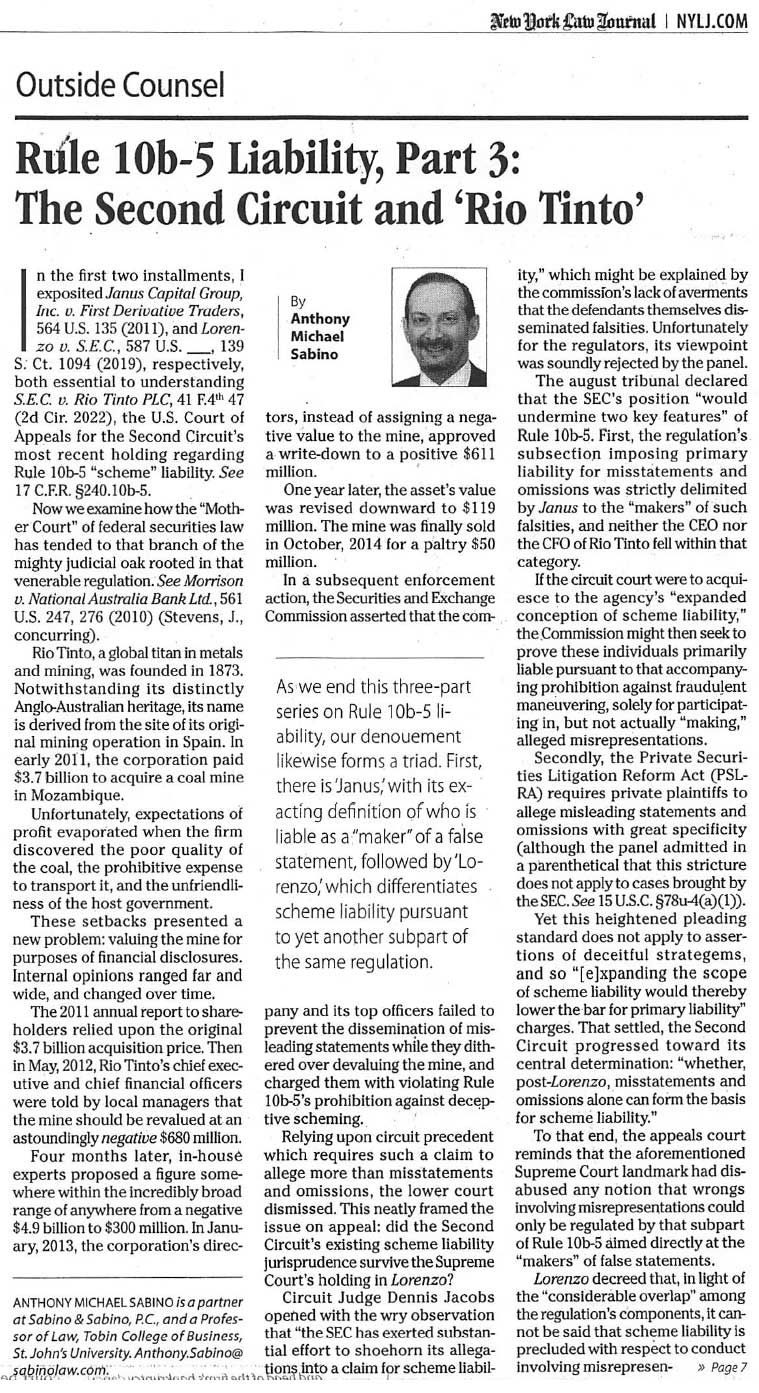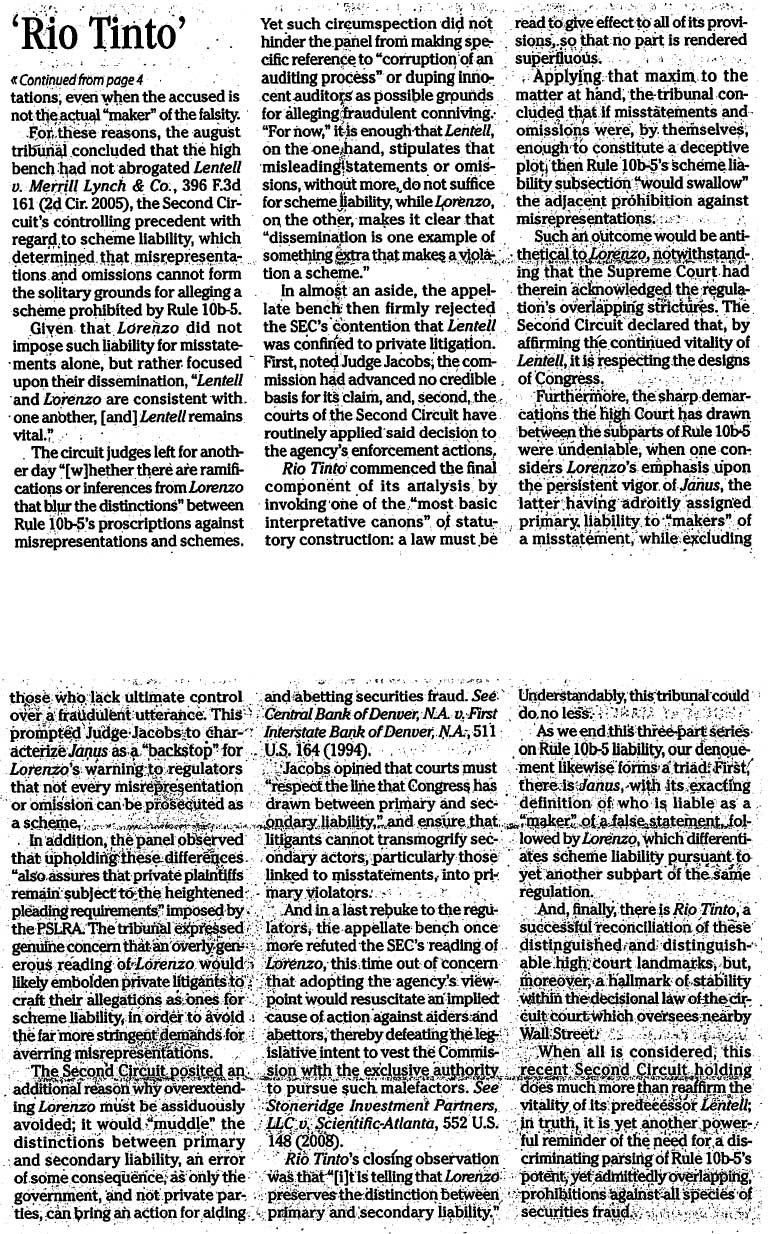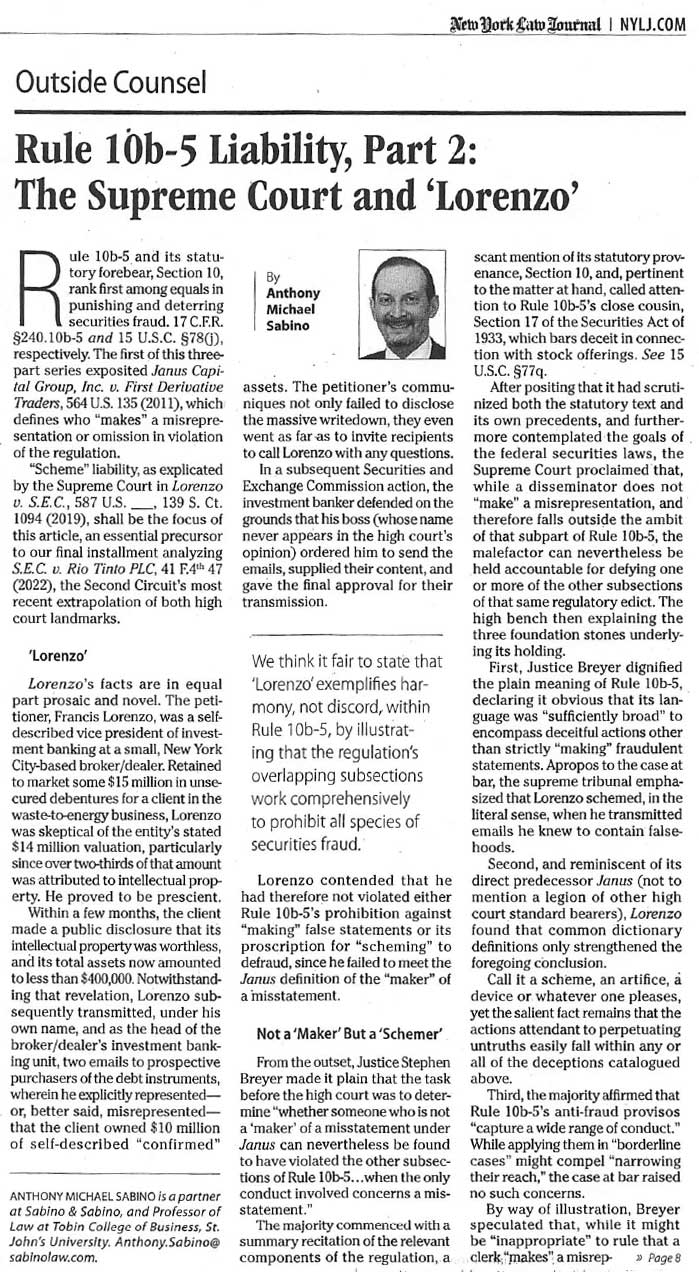


a misrepresentation merely by mailing out another’s falsities, in contradistinction the petitioner now before the high bench willfully transmitted misleading information directly to potential investors, welcomed further inquiries, and did so as his employer’s head of investment banking.
In addition to arguing that only those who actually “make” untrue statements run afoul of the pertinent component of Rule 10b-5, Lorenzo also asserted that the regulation’s adjacent subparagraph barring deceptive schemes is applicable only to wrongdoing other than misstatements.
Any contrary reading, the petitioner urged, would render at least some of the rule superfluous. As characterized by Breyer, “[t]he premise of this argument is that each of these provisions should be read as governing different, mutually exclusive spheres of conduct.”
The majority swiftly rebuffed that contention, as it contradicted the established maxim that Rule 10b-5 contains “considerable overlap” among its own subsections, not to mention with other securities-related provisions.
There is no novelty, opined Justice Breyer, to the proposition that different portions of the securities acts outlaw the same conduct. See also Herman & MacLean & Huddleston, 459 U.S. 375 (1983).
The intent of the securities codes has always been to comprehensively forbid all wrongdoing, without narrowing the reach of any particular statute. Accordingly, it is not surplusage when generic proscriptions proceed in the company of more specific prohibitions, as they often do. See U.S. v. Naftalin, 441 U.S. 768 (1979) (long the benchmark for Section 17 liability).
It would be disconcerting, proclaimed the high bench, to adopt the petitioner’s argument that the regulation’s provisos were mutually exclusive. Disseminators of false statements “might [then] escape liability…altogether,” an outcome antithetical to the mandate for full and truthful disclosure in securities transactions.
The better approach, by far, would be to give unabridged effect to Rule 10b-5’s “expansive language,” and thereby reject Lorenzo’s isolationist interpretation of the same text.
But what of this petitioner’s other, admittedly significant, contentions, the first of which was that holding him culpable of scheming would effectively nullify the precedent recently established in Janus?
Justice Breyer summarily dispensed with that allegation, pointing out that the earlier landmark addressed itself to the “making” of purportedly fraudulent statements, and not the dissemination of misleading material. Therefore, an affirmation of scheme liability in the matter now before the high bench could do no harm to the efficacy of Janus.
Lorenzo’s second argument struck a similar chord; he purported that a ruling against him in the case at bar would blur the division between primary and secondary liability for violating the federal securities laws, a distinction assiduously crafted by the Supreme Court three decades ago in Central Bank of Denver, N.A. v. First Interstate Bank of Denver, N.A., 511 U.S. 164 (1994).
The majority rebuffed that point as well, postulating that “[w]e do not believe…that our decision creates a serious anomaly or otherwise weakens” Central Bank’s core holdings. It is “hardly unusual,” opined Breyer, “for the same conduct to be a primary violation with respect to one offense and aiding and abetting with respect to another.”
Furthermore, the petitioner not only misapprehended Central Bank, he misunderstood its relationship to Janus. Just as the former suggested the need for clear borders separating primary from secondary wrongdoing, the latter honored that differentiation by neatly partitioning the “maker” of a misrepresentation from actors too far removed to exercise final control over that same falsehood.
By decreeing that disseminators of deceitful utterances are liable pursuant to discrete subsections of Rule 10b-5, “even if they are secondarily liable” under the “making” proviso of that same regulation, Lorenzo shall be “just as administrable” as its antecedents.
And as for the investment banker’s lament that now “peripheral players” will henceforth suffer from substantial exposure, Justice Breyer tartly retorted that “the investors who received Lorenzo’s e-mails would not view the deception so favorably.”
Almost as an afterthought, the majority brusquely rejected the petitioner’s invocation of Stoneridge Investment Partners, LLC v. Scientific-Atlanta, Inc., 552 U.S. 148 (2008), reminding that the SEC, unlike private plaintiffs, need not show reliance in its enforcement actions.
Yet even if the regulators were required to make such a showing, it would be easily met, given that Lorenzo’s conduct entailed “direct transmission of false statements to prospective investors,” a step undoubtedly intended to induce reliance. “Congress intended to root out all manner of fraud in the securities industry,” the high court robustly concluded, “[a]nd it gave to the Commission the tools to accomplish that job.”
For our own ending, we think it fair to state that Lorenzo exemplifies harmony, not discord, within Rule 10b-5, by illustrating that the regulation’s overlapping subsections work comprehensively to prohibit all species of securities fraud.
Simultaneously, this decision of the Supreme Court resonates with its other landmarks applying the rule in a diversity of situations. Having completed the necessary exposition of the kindred holdings of Janus and Lorenzo, our final installment shall exposit how the Second Circuit relied upon these precedents to decide Rio Tinto.
Anthony Michael Sabino is a partner at Sabino & Sabino, and Professor of Law at Tobin College of Business, St. John’s University. [email protected].
The author’s goal of his three-part series is to ultimately discuss the Second Circuit’s recent Securities law landmark case, S.E.C. v. Rio Tinto. However, in order to discuss Rio Tinto, he believes it is important to first understand the Supreme Court cases upon which Rio Tinto is based: Janus Capital Group, Inc. v. First Derivative Trader, discussed in the first installment, and S.E.C v. Lorenzo, discussed here.
March 22, 2023 at 10:00 AM
By Anthony Michael Sabino | March 22, 2023 at 10:00 AM
Rule 10b-5 and its statutory forebear, Section 10, rank first among equals in punishing and deterring securities fraud. 17 C.F.R. §240.10b-5 and 15 U.S.C. §78(j), respectively. The first of this three-part series exposited Janus Capital Group, Inc. v. First Derivative Traders, 564 U.S. 135 (2011), which defines who “makes” a misrepresentation or omission in violation of the regulation.
“Scheme” liability, as explicated by the Supreme Court in Lorenzo v. S.E.C., 587 U.S. ___, 139 S. Ct. 1094 (2019), shall be the focus of this article, an essential precursor to our final installment analyzing S.E.C. v. Rio Tinto PLC, 41 F.4th 47 (2022), the Second Circuit’s most recent extrapolation of both high court landmarks.
Lorenzo’s facts are in equal part prosaic and novel. The petitioner, Francis Lorenzo, was a self-described vice president of investment banking at a small, New York City-based broker/dealer. Retained to market some $15 million in unsecured debentures for a client in the waste-to-energy business, Lorenzo was skeptical of the entity’s stated $14 million valuation, particularly since over two-thirds of that amount was attributed to intellectual property. He proved to be prescient.
Within a few months, the client made a public disclosure that its intellectual property was worthless, and its total assets now amounted to less than $400,000. Notwithstanding that revelation, Lorenzo subsequently transmitted, under his own name, and as the head of the broker/dealer’s investment banking unit, two emails to prospective purchasers of the debt instruments, wherein he explicitly represented—or, better said, misrepresented—that the client owned $10 million of self-described “confirmed” assets. The petitioner’s communiques not only failed to disclose the massive writedown, they even went as far as to invite recipients to call Lorenzo with any questions.
In a subsequent Securities and Exchange Commission action, the investment banker defended on the grounds that his boss (whose name never appears in the high court’s opinion) ordered him to send the emails, supplied their content, and gave the final approval for their transmission.
Lorenzo contended that he had therefore not violated either Rule 10b-5’s prohibition against “making” false statements or its proscription for “scheming” to defraud, since he failed to meet the Janus definition of the “maker” of a misstatement.
From the outset, Justice Stephen Breyer made it plain that the task before the high court was to determine “whether someone who is not a ‘maker’ of a misstatement under Janus can nevertheless be found to have violated the other subsections of Rule 10b-5…when the only conduct involved concerns a misstatement.”
The majority commenced with a summary recitation of the relevant components of the regulation, a scant mention of its statutory provenance, Section 10, and, pertinent to the matter at hand, called attention to Rule 10b-5’s close cousin, Section 17 of the Securities Act of 1933, which bars deceit in connection with stock offerings. See 15 U.S.C. §77q.
After positing that it had scrutinized both the statutory text and its own precedents, and furthermore contemplated the goals of the federal securities laws, the Supreme Court proclaimed that, while a disseminator does not “make” a misrepresentation, and therefore falls outside the ambit of that subpart of Rule 10b-5, the malefactor can nevertheless be held accountable for defying one or more of the other subsections of that same regulatory edict. The high bench then explaining the three foundation stones underlying its holding.
First, Justice Breyer dignified the plain meaning of Rule 10b-5, declaring it obvious that its language was “sufficiently broad” to encompass deceitful actions other than strictly “making” fraudulent statements. Apropos to the case at bar, the supreme tribunal emphasized that Lorenzo schemed, in the literal sense, when he transmitted emails he knew to contain falsehoods.
Second, and reminiscent of its direct predecessor Janus (not to mention a legion of other high court standard bearers), Lorenzo found that common dictionary definitions only strengthened the foregoing conclusion.
Call it a scheme, an artifice, a device or whatever one pleases, yet the salient fact remains that the actions attendant to perpetuating untruths easily fall within any or all of the deceptions catalogued above.
Third, the majority affirmed that Rule 10b-5’s anti-fraud provisos “capture a wide range of conduct.” While applying them in “borderline cases” might compel “narrowing their reach,” the case at bar raised no such concerns.
By way of illustration, Breyer speculated that, while it might be “inappropriate” to rule that a clerk “makes” a misrepresentation merely by mailing out another’s falsities, in contradistinction the petitioner now before the high bench willfully transmitted misleading information directly to potential investors, welcomed further inquiries, and did so as his employer’s head of investment banking.
In addition to arguing that only those who actually “make” untrue statements run afoul of the pertinent component of Rule 10b-5, Lorenzo also asserted that the regulation’s adjacent subparagraph barring deceptive schemes is applicable only to wrongdoing other than misstatements.
Any contrary reading, the petitioner urged, would render at least some of the rule superfluous. As characterized by Breyer, “[t]he premise of this argument is that each of these provisions should be read as governing different, mutually exclusive spheres of conduct.”
The majority swiftly rebuffed that contention, as it contradicted the established maxim that Rule 10b-5 contains “considerable overlap” among its own subsections, not to mention with other securities-related provisions.
There is no novelty, opined Justice Breyer, to the proposition that different portions of the securities acts outlaw the same conduct. See also Herman & MacLean & Huddleston, 459 U.S. 375 (1983).
The intent of the securities codes has always been to comprehensively forbid all wrongdoing, without narrowing the reach of any particular statute. Accordingly, it is not surplusage when generic proscriptions proceed in the company of more specific prohibitions, as they often do. See U.S. v. Naftalin, 441 U.S. 768 (1979) (long the benchmark for Section 17 liability).
It would be disconcerting, proclaimed the high bench, to adopt the petitioner’s argument that the regulation’s provisos were mutually exclusive. Disseminators of false statements “might [then] escape liability…altogether,” an outcome antithetical to the mandate for full and truthful disclosure in securities transactions.
The better approach, by far, would be to give unabridged effect to Rule 10b-5’s “expansive language,” and thereby reject Lorenzo’s isolationist interpretation of the same text.
But what of this petitioner’s other, admittedly significant, contentions, the first of which was that holding him culpable of scheming would effectively nullify the precedent recently established in Janus?
Justice Breyer summarily dispensed with that allegation, pointing out that the earlier landmark addressed itself to the “making” of purportedly fraudulent statements, and not the dissemination of misleading material. Therefore, an affirmation of scheme liability in the matter now before the high bench could do no harm to the efficacy of Janus.
Lorenzo’s second argument struck a similar chord; he purported that a ruling against him in the case at bar would blur the division between primary and secondary liability for violating the federal securities laws, a distinction assiduously crafted by the Supreme Court three decades ago in Central Bank of Denver, N.A. v. First Interstate Bank of Denver, N.A., 511 U.S. 164 (1994).
The majority rebuffed that point as well, postulating that “[w]e do not believe…that our decision creates a serious anomaly or otherwise weakens” Central Bank’s core holdings. It is “hardly unusual,” opined Breyer, “for the same conduct to be a primary violation with respect to one offense and aiding and abetting with respect to another.”
Furthermore, the petitioner not only misapprehended Central Bank, he misunderstood its relationship to Janus. Just as the former suggested the need for clear borders separating primary from secondary wrongdoing, the latter honored that differentiation by neatly partitioning the “maker” of a misrepresentation from actors too far removed to exercise final control over that same falsehood.
By decreeing that disseminators of deceitful utterances are liable pursuant to discrete subsections of Rule 10b-5, “even if they are secondarily liable” under the “making” proviso of that same regulation, Lorenzo shall be “just as administrable” as its antecedents.
And as for the investment banker’s lament that now “peripheral players” will henceforth suffer from substantial exposure, Justice Breyer tartly retorted that “the investors who received Lorenzo’s e-mails would not view the deception so favorably.”
Almost as an afterthought, the majority brusquely rejected the petitioner’s invocation of Stoneridge Investment Partners, LLC v. Scientific-Atlanta, Inc., 552 U.S. 148 (2008), reminding that the SEC, unlike private plaintiffs, need not show reliance in its enforcement actions.
Yet even if the regulators were required to make such a showing, it would be easily met, given that Lorenzo’s conduct entailed “direct transmission of false statements to prospective investors,” a step undoubtedly intended to induce reliance. “Congress intended to root out all manner of fraud in the securities industry,” the high court robustly concluded, “[a]nd it gave to the Commission the tools to accomplish that job.”
For our own ending, we think it fair to state that Lorenzo exemplifies harmony, not discord, within Rule 10b-5, by illustrating that the regulation’s overlapping subsections work comprehensively to prohibit all species of securities fraud.
Simultaneously, this decision of the Supreme Court resonates with its other landmarks applying the rule in a diversity of situations. Having completed the necessary exposition of the kindred holdings of Janus and Lorenzo, our final installment shall exposit how the Second Circuit relied upon these precedents to decide Rio Tinto.
Anthony Michael Sabino is a partner at Sabino & Sabino, and Professor of Law at Tobin College of Business, St. John’s University. [email protected].